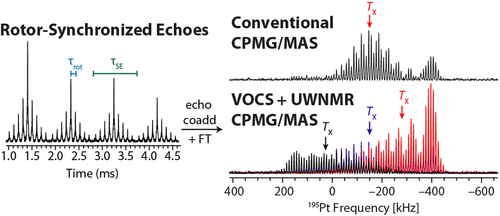当前位置:
X-MOL 学术
›
J. Phys. Chem. C
›
论文详情
Our official English website, www.x-mol.net, welcomes your
feedback! (Note: you will need to create a separate account there.)
Practical Aspects of Recording Ultra-Wideline NMR Patterns under Magic-Angle Spinning Conditions
The Journal of Physical Chemistry C ( IF 3.3 ) Pub Date : 2020-06-08 , DOI: 10.1021/acs.jpcc.0c04510 Adam R. Altenhof 1, 2 , Michael J. Jaroszewicz 3 , Austin W. Lindquist 3 , Lucas D. D. Foster 3 , Stanislav L. Veinberg 3 , Robert W. Schurko 1, 2
The Journal of Physical Chemistry C ( IF 3.3 ) Pub Date : 2020-06-08 , DOI: 10.1021/acs.jpcc.0c04510 Adam R. Altenhof 1, 2 , Michael J. Jaroszewicz 3 , Austin W. Lindquist 3 , Lucas D. D. Foster 3 , Stanislav L. Veinberg 3 , Robert W. Schurko 1, 2
Affiliation

|
Many NMR-active nuclei give rise to solid-state NMR spectra that span extremely large frequency regions due to the effects of large anisotropic NMR interactions; such spectra, which can range from 250 kHz to several MHz in breadth, have been termed ultra-wideline (UW) NMR spectra. UWNMR spectra are often too broad to be uniformly excited by conventional pulse sequences that implement rectangular radiofrequency (RF) pulses. Therefore, they are typically acquired with specialized pulse sequences and frequency-swept (FS) pulses; however, such experiments are conducted predominantly upon stationary samples (i.e., static NMR with no magic-angle spinning, MAS). Herein, we demonstrate how to implement Carr–Purcell Meiboom–Gill (CPMG) type pulse sequences that utilize rectangular pulses to acquire high-quality wideline and UWNMR spectra under MAS conditions, which are useful for providing uniformly excited patterns with substantial signal enhancements in comparison to conventional MAS NMR spectra and identifying peaks and/or patterns corresponding to magnetically nonequivalent sites. We discuss the pulse timings, delays, and the duration of windowed acquisition periods that are necessary for using CPMG-type pulse sequences for T2-dependent enhancement under MAS conditions while allowing for chemical shift resolution and maintaining a conventional spinning-sideband (SSB) manifold, as well as protocols for processing these spectra. Careful consideration is given to pulse lengths and RF amplitudes used in these pulse sequences. Using several spin-1/2 (i.e., 119Sn, 207Pb, 195Pt) nuclei and one integer-spin quadrupolar nucleus (i.e., 2H), we show how sensitivity-enhancing protocols, including CPMG and cross-polarization (CP), can be used to deliver high-quality MAS NMR spectra, which feature high signal-to-noise (S/N) ratios and uniformly excited SSB manifolds. The methods outlined herein are facile to implement and offer the potential to open up MAS NMR experiments to a wide variety of elements from across the periodic table.
中文翻译:

在魔角旋转条件下记录超宽核磁共振图谱的实践方面
由于具有较大的各向异性NMR相互作用,许多NMR活性核会产生跨越非常大频率区域的固态NMR光谱。这种光谱的宽度范围从250 kHz到几MHz,已被称为超宽线(UW)NMR光谱。UWNMR谱通常太宽而无法被实现矩形射频(RF)脉冲的常规脉冲序列均匀激发。因此,通常使用专门的脉冲序列和频率扫描(FS)脉冲来获取它们。但是,此类实验主要在固定样本上进行(即静态NMR,无魔角旋转,MAS)。在这里 我们演示了如何实现Carr–Purcell Meiboom–Gill(CPMG)型脉冲序列,该序列利用矩形脉冲在MAS条件下获取高质量的宽线和UWNMR谱图,与传统方法相比,该方法可用于提供均匀的,增强信号的模式MAS NMR光谱和识别对应于磁性非等价位点的峰和/或谱图。我们讨论了使用CPMG型脉冲序列进行脉冲采样所必需的脉冲定时,延迟和窗口采集周期的持续时间。在MAS条件下依赖T 2的增强,同时允许化学位移分辨率和维持常规的旋转边带(SSB)歧管,以及处理这些光谱的协议。仔细考虑在这些脉冲序列中使用的脉冲长度和RF幅度。使用几种旋1 / 2(即,119的Sn,207铅,195 Pt)的核和一个整数自旋的四极原子核(即,2 2H),我们显示如何灵敏度增强协议,包括CPMG和交叉极化(CP ),可用于提供高质量的MAS NMR光谱,该光谱具有高信噪比(S / N比率和均匀激发的SSB流形。本文概述的方法易于实施,并提供了将MAS NMR实验开放到周期表中多种元素的潜力。
更新日期:2020-07-09
中文翻译:

在魔角旋转条件下记录超宽核磁共振图谱的实践方面
由于具有较大的各向异性NMR相互作用,许多NMR活性核会产生跨越非常大频率区域的固态NMR光谱。这种光谱的宽度范围从250 kHz到几MHz,已被称为超宽线(UW)NMR光谱。UWNMR谱通常太宽而无法被实现矩形射频(RF)脉冲的常规脉冲序列均匀激发。因此,通常使用专门的脉冲序列和频率扫描(FS)脉冲来获取它们。但是,此类实验主要在固定样本上进行(即静态NMR,无魔角旋转,MAS)。在这里 我们演示了如何实现Carr–Purcell Meiboom–Gill(CPMG)型脉冲序列,该序列利用矩形脉冲在MAS条件下获取高质量的宽线和UWNMR谱图,与传统方法相比,该方法可用于提供均匀的,增强信号的模式MAS NMR光谱和识别对应于磁性非等价位点的峰和/或谱图。我们讨论了使用CPMG型脉冲序列进行脉冲采样所必需的脉冲定时,延迟和窗口采集周期的持续时间。在MAS条件下依赖T 2的增强,同时允许化学位移分辨率和维持常规的旋转边带(SSB)歧管,以及处理这些光谱的协议。仔细考虑在这些脉冲序列中使用的脉冲长度和RF幅度。使用几种旋1 / 2(即,119的Sn,207铅,195 Pt)的核和一个整数自旋的四极原子核(即,2 2H),我们显示如何灵敏度增强协议,包括CPMG和交叉极化(CP ),可用于提供高质量的MAS NMR光谱,该光谱具有高信噪比(S / N比率和均匀激发的SSB流形。本文概述的方法易于实施,并提供了将MAS NMR实验开放到周期表中多种元素的潜力。











































 京公网安备 11010802027423号
京公网安备 11010802027423号